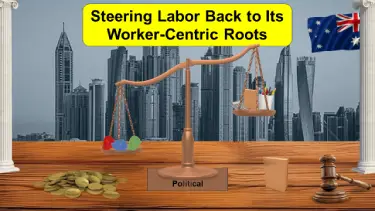Description:
Australias Labor Party. Examine how right-factions have shaped the ALP’s policies and the challenges of leadership under Anthony Albanese.
1. Introduction
Over the past few decades, the Australias Labor Party (ALP) has experienced a noticeable shift from its traditional labor-oriented ideology to a stance that often mirrors the centrist or right-leaning policies of the Liberal National Party (LNP). This transformation has sparked significant debate and concern among its traditional base.
This ideological drift is not just a matter of party politics; it has profound implications for policymaking and the welfare of the Australian working class. The change has affected Labor’s ability to serve as a distinctive voice for progressive and worker-centric policies.
This article will explore the historical context of this shift, identify the key factors and figures behind the rise of the right factions within the ALP, examine the impact of these changes on party policies and public perception, and discuss potential strategies for realigning the party with its foundational principles.
2. Historical Perspective
Labor’s Founding Ideals: Founded in the early 20th century, the ALP was set up with the express purpose of standing for the labor interests of Australians, advocating for workers’ rights, and promoting social justice.

Key Milestones and Shifts: Throughout its history, the ALP has been pivotal in advancing worker protections, social welfare programs, and advocating for public ownership of key industries. However, during the late 20th century, global economic pressures and the rise of neoliberalism influenced the party’s policies, leading to a gradual shift toward the centre.
Early Signs of Ideological Shift: The shift became more pronounced under the leadership of figures like Bob Hawke and Paul Keating in the 1980s and 1990s, who embraced deregulation, privatization, and a reduction in tariffs, aligning more with market-oriented reforms.
3. Rise of the Right-Factions
Key Figures and Influencers: As the ALP has experienced ideological shifts under various leaders, prominent figures such as Kevin Rudd, Julia Gillard, and more recently, Bill Shorten, have each played roles in navigating the party’s trajectory toward more centrist and right-leaning positions. These leaders, often influenced by the party’s right factions, have pushed policies closer to those traditionally held by conservative or far-right groups.
This includes prioritizing market-oriented economic policies and adopting tougher stances on issues like immigration and national security, areas which historically align more closely with conservative ideologies. The leadership of Anthony Albanese, although originating from the party’s left faction, continues to face challenges in balancing these factional influences while trying to uphold the party’s traditional labor values.
Strategic Decisions: The strategic decisions that have pushed the party towards these ideologies often involve key policy shifts intended to appeal to a broader or different voter demographic. This could include adopting stringent welfare policies, advocating for aggressive national security measures, or supporting corporate tax cuts, which are generally associated with conservative politics.
External Influences: The drift towards far-right positions may also be influenced by an increased alignment with corporate interests that favor deregulation and privatization, as well as a media landscape that promotes conservative values. Additionally, global political trends towards populism and nationalism might be playing a role in shaping party policies and rhetoric, pushing the ALP further right than merely centrist.
Impact of these Shifts: This perceived movement towards far-right ideologies could be causing significant discontent within the party’s traditional base, who may view these changes as a betrayal of the party’s foundational principles. It also risks alienating voters who are sensitive to issues like social justice, environmental protection, and workers’ rights, which have historically been aligned with the ALP.
Internal Responses and Critiques: Within the party, there may be growing calls for a re-evaluation of these rightward shifts, led by members and factions that advocate a return to more traditional, progressive Labor policies. These internal dynamics are crucial for understanding how the party might realign itself with its original values or continue on its current trajectory.
Navigating Factional Power: The Realities of Leadership in the ALP
1. Factional Influence: In large political parties like the ALP, factions play significant roles in shaping policy and leadership decisions. The idea that Anthony Albanese, associated with the Left faction, could be seen as a “token” leader implies that despite his factional alignment, the dominant right factions keep substantial control over the party’s direction. This situation would highlight a possible disconnect between the leader’s public ideological stance and the actual policy directions enforced by more powerful internal groups.
2. Leadership Autonomy: The notion of a leader acting under the constraints imposed by other factions raises questions about the autonomy and influence of the party leader. It suggests that the leader may not have full freedom to implement their own policy vision, which could lead to compromises that align more closely with the preferences of the dominant faction rather than their own or their faction’s ideals.
3. Strategic Considerations: Choosing a leader from a different faction might be a strategic move to present a united or diverse front to the public, aiming to appeal to a broader electorate by showing inclusivity of different views within the party. However, if the leader is perceived as not having actual power over policy decisions, it might affect public trust and the credibility of the party.
4. Implications for Policy and Governance: If a party leader is perceived as being a token figurehead, it could impact the effectiveness of governance and the implementation of coherent policies. Voters might feel disillusioned if they believe that election promises aligned with the leader’s ideology won’t be fulfilled.
In conclusion, such a scenario points to deeper issues within party structures, such as the balance of power, transparency in decision-making, and the authenticity of representative politics. For party supporters and the general electorate, understanding these dynamics is crucial for making informed decisions about their support and expectations from the party.
Strategic Decisions
Election Strategies: Australias Labor Party has made calculated decisions about its election strategies that reflect a shift toward right-leaning policies. This includes targeting middle-class voters and swing electorates where conservative views are more prevalent. Campaigns have increasingly focused on economic stability and security, which often resonate with conservative voters, rather than traditional labor themes such as workers’ rights and social justice.
Policy Compromises: To appeal to a broader electorate, the ALP has often compromised on its traditional policy stances. This includes softening its approach to economic regulation, reducing emphasis on income redistribution, and adopting more stringent measures on immigration and border control. These compromises are often seen as necessary to win over voters who might otherwise support more conservative parties.
Leadership Selection: The choice of party leaders has also been a strategic decision that affects the ideological direction of the party. By choosing leaders who can appeal to centrist and right-leaning voters, such as Anthony Albanese, the party aims to present a more moderate face. However, this has led to tensions within the party, as these leaders must balance the demands of right-leaning factions with the expectations of the traditional left-wing base.
Alliance and Coalition Building: Strategic decisions about alliances and coalitions have also reflected a shift towards the right. Australias Labor Party has at times chosen to align with moderate or right-leaning groups on certain policy issues to secure legislative victories, even if these alliances stray from the party’s traditional values. This pragmatic approach to politics is often justified to achieve greater influence and implement some party policies, but it can dilute the party’s ideological purity.
Handling of Internal Disputes: The management of internal disputes within the party also reflects strategic decision-making. Leaders have often had to navigate between the demands of different factions, choosing to sideline more radical elements of the party in favour of a more unified, centrist approach. This has included disciplining members or reshuffling positions to strengthen the hand of those advocating for more centrist policies.
External Influences
Corporate Influence: One of the most significant external factors has been the increasing influence of corporate interests on the ALP’s policy-making process. As the party has looked to broaden its appeal and secure funding, it has become more receptive to the agendas of large corporations and business lobbyists. This has manifested in policies that favour deregulation, tax reforms beneficial to businesses, and privatization of public assets, which align with corporate but not always public interests.
 Media Landscape: The role of the media in shaping political narratives cannot be underestimated. Australia’s media landscape, dominated by a few powerful conglomerates, has often framed political debates in a way that favours market-oriented reforms and conservative social policies. This media influence has pressured the ALP to adopt more centrist positions to avoid negative coverage and appeal to a broader electorate as portrayed by mainstream media.
Media Landscape: The role of the media in shaping political narratives cannot be underestimated. Australia’s media landscape, dominated by a few powerful conglomerates, has often framed political debates in a way that favours market-oriented reforms and conservative social policies. This media influence has pressured the ALP to adopt more centrist positions to avoid negative coverage and appeal to a broader electorate as portrayed by mainstream media.
Global Political Trends: The rise of global neoliberalism and right-wing populism has also affected the ALP’s strategic direction. As political parties around the world shift rightward to capture disaffected voters, the ALP has similarly adjusted some of its policies in response to global economic pressures and security concerns. This includes tougher stances on immigration and national security, often reflecting broader international trends rather than traditional Labor values.
Interactions with Other Political Parties: The dynamics between the ALP and other parties, including the Greens and the Liberal National Party (LNP), also exert significant external pressure. The need to differentiate itself from the Greens on environmental and social policies while also countering the economic policies of the LNP has led to a complex balancing act, where the ALP often positions itself as a middle ground, affecting its ideological stance and policy decisions.
Impact of these Shifts

Policy Changes: The ideological shifts towards right-leaning policies have significantly influenced the ALP’s stance on economic, social, and security issues. For example, the party has increasingly embraced neoliberal economic policies, such as deregulation and privatization, which contrast with its historical commitment to public welfare and labor protections. This includes reforms in areas like public sector employment and social security, which have seen reductions in benefits and protections for workers.
Public Reaction: These policy shifts have sparked a range of reactions among the public and the party’s traditional base. While some voters appreciate what they see as pragmatic responses to global economic pressures, others feel alienated, believing that the party has abandoned its core principles of supporting the working class and vulnerable populations. This disillusionment is particularly palpable among younger voters and those in sectors most affected by economic precarity.
Electoral Consequences: The changes have had mixed electoral consequences for the ALP. On one hand, the party has managed to attract some middle-class voters who may have previously leaned towards conservative parties. On the other hand, there has been a noticeable drift of traditional labor supporters towards other parties, including the Greens and more progressive independents, especially in urban areas where voters are more sensitive to issues like climate change and social justice. The ALP’s ability to form government has often hinged on its ability to present a compelling alternative to the Liberal National Party, which it has struggled with during elections where its identity appears conflated with broader right-wing agendas.
Internal Party Dynamics: The shift has also intensified internal debates and factional struggles within the ALP, with significant implications for leadership stability and policy direction. The tension between progressive ideals and centrist strategies continues to shape the party’s strategic decisions and public messaging, leading to a sometimes inconsistent or contradictory policy platform.
4. Impact on Policy and Public Perception
Policy Changes: The Australias Labor Party ideological shift towards the right has led to significant policy adjustments. These include a more conservative approach to economic management, such as favouring corporate tax cuts and promoting private investment in national infrastructure projects, which marks a departure from traditional labor economics. Social policies have also seen shifts, with moderated stances on welfare entitlements, aiming to appeal to a broader electorate by reducing perceived dependency on government support.
Impact on Public Services: The rightward shift has had tangible effects on public services, particularly in healthcare, education, and social welfare. For instance, there have been moves towards the privatization of certain public assets and a focus on ‘efficiency’ that critics argue undermines service quality and accessibility. These changes often result in cost-cutting measures that disproportionally affect the most vulnerable segments of society, creating a divide in public opinion about the party’s commitments to social equity.
Public Reaction: This ideological realignment has stirred significant debate among the electorate. Traditional labor supporters often express disillusionment, feeling that the party has abandoned its core principles. However, some segments appreciate what they perceive as a more ‘modern’ and ‘pragmatic’ approach to governance. The ALP’s challenge lies in balancing these diverse expectations without alienating its base.
Electoral Consequences: Electorally, the Australias Labor Party rightward drift has had mixed outcomes. While it may have helped the party gain traction among more conservative voters who might typically lean towards the Liberal National Party (LNP), it has also led to losses among its traditional base, who may feel their interests are better represented by parties like the Greens or other progressive groups. This tension is often reflected in election results where the ALP struggles to combine its traditional base while trying to expand its appeal.
Perception of Authenticity and Trust: The ideological shifts have also affected the party’s perceived authenticity and trust among voters. As policies increasingly reflect right-leaning ideologies, some voters question the ALP’s commitment to its historical labor roots. This scepticism can affect voter turnout and enthusiasm, particularly among younger and more progressive segments of the electorate who prioritize transparency and integrity in their political choices.
5. Comparison with Other Labor Movements Globally
Internationally, parties like the UK Labour Party and the US Democratic Party have also grappled with balancing core values with broader appeal. These examples offer lessons on the risks and rewards of ideological shifts within major labor parties.
6. Pathways to Reformation
Reviving Australias Labor Party commitment to its original values may involve diminishing the influence of right-leaning factions, strengthening ties with unions and grassroots movements, and promoting leaders who genuinely represent the party’s foundational ideologies.
7. Conclusion
Australias Labor Party stands at a crossroads, where it must decide whether to continue its current path or realign itself with the principles that once defined its identity. For supporters and members, engaging actively in shaping the party’s future is crucial to ensure it is still a vital force for progressive change in Australia.
Call to Action
If you found this article insightful, explore more about political reform and Australia’s monetary sovereignty on Social Justice Australia: https://socialjusticeaustralia.com.au/.
Share this article with your community to help drive the conversation toward a more just and equal society.
Click on our “Reader Feedback” menu. Let us know how our content has inspired you. Submit your testimonial and help shape the conversation today!
Additionally, leave a comment about this article below.


Where the ALP is standing now, I will not be supporting them in any way. There are way too many right-wing factions in this leadership and it may as well be the LNP. They have very scarcely attempted to achieved what they promise prior to the last election and they have no backbone nor support the working people.
Hi Anne,
Thank you for your comment. It is disappointing that Labor have moved so far to the right and the parties courage leaves a lot to be desired.
Hello Anne,
I’m with you. I think the Labor Party has been taken over by the right factions of the party. In many aspects, they are not that different to the LNP.
I am slightly disappointed with Labor and have wished for another Gough for decades. I can understand the money management problem because I believe the Electorate is dumbed down and very conservative. However matters like AUKUS worry me and most of my friends, Liberal or Labor voters. I believe there is more room to return to a more social and Left position than the Party obviously thinks.
Hi Rob,
I believe you are not along in feeling disappointed with Labor. Many diehard Labor supporters were expecting a more focus on social justice issues and the well-being of all citizens, but instead they are aligned more closely to the LNP.
Hi Rob,
You are not alone with your disappointment in Labor. Many die-hard Labor supporters in my Facebook groups expected much more of a lean towards social justice.
An excellent article of succinct and astute observations (and spot-on as far as I’m concerned), while not pushing some editorial opinions down one’s throat.
Hi Allan,
Thank you for your feedback. I do my best to provide thoughtful and factual articles with the aim of our political system working for the benefit of all citizens.
Hi Allan,
Thank you for taking the time to give your feedback.